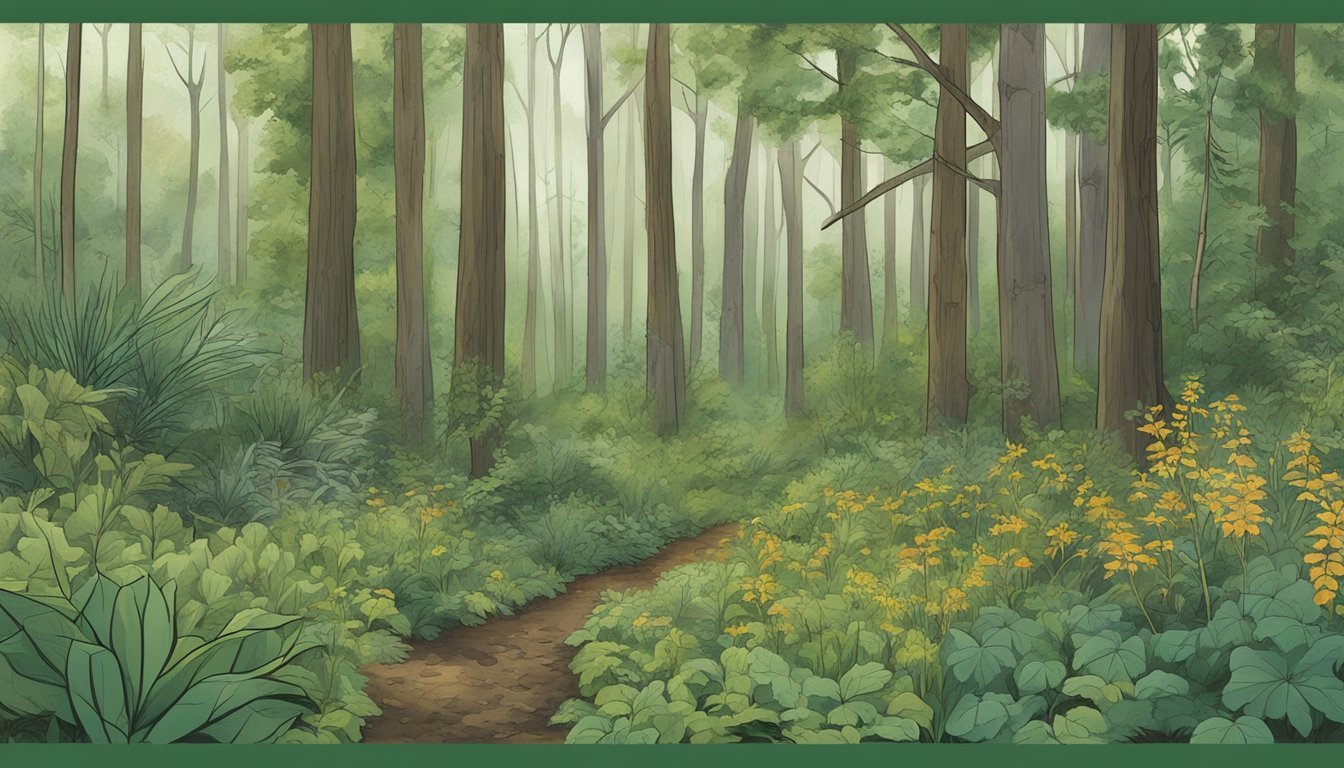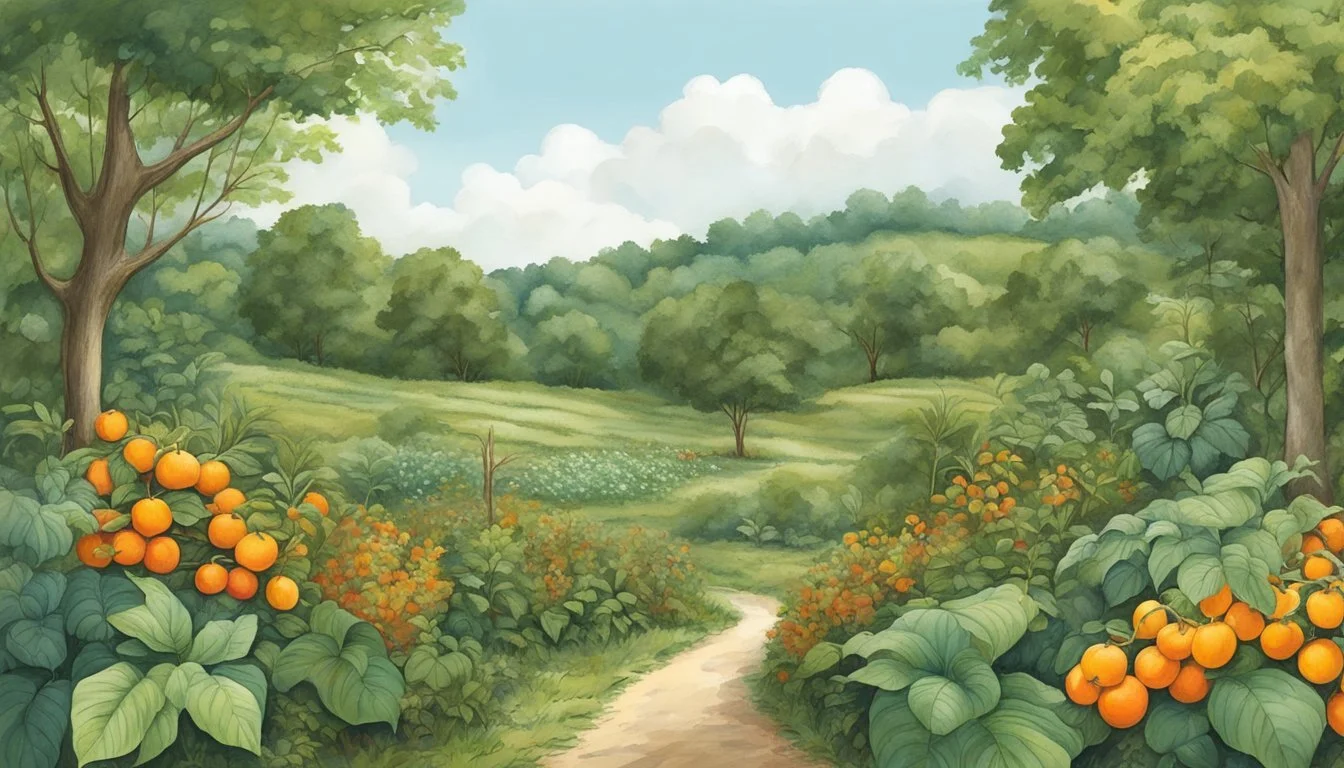Native Edible Plants in Missouri
A Guide to Foraging and Identification
This Article is Part of Foraging Guide for All 50 US States
Missouri's diverse ecosystems are a treasure trove of native plants, many of which are edible and have been part of the regional diet for centuries. From the Ozark Mountains to the northern plains, foragers and culinary enthusiasts can find a variety of plants that offer both nutritional value and historical significance. These plants range from roots and berries to leaves and seeds, (how long do seeds last?) each offering a unique flavor and set of benefits. For example, the pawpaw fruit, often found in the state's river bottom forests, is rich in nutrients and has a tropical flavor that belies its temperate origins.
In addition to pawpaw, the state is home to a plethora of other edible native species. The persimmon tree yields fruit that, when fully ripe, provides a sweet and custardy treat, while the serviceberry produces berries that are both delicious raw and useful in preserves and baking. These species not only contribute to local cuisine but also play important roles in Missouri's ecosystems, supporting biodiversity and providing food for wildlife. For those interested in sustainable and locally-sourced foods, Missouri offers an abundance of native plants that are waiting to be rediscovered and integrated into modern recipes.
As interest in foraging and natural foods continues to grow, the knowledge of how to safely identify and prepare these native edibles is crucial. In Missouri, where the seasons can greatly affect the availability and quality of these plants, understanding the optimal times for harvesting can greatly enhance the foraging experience. This direct connection to the land fosters appreciation for the state's natural resources and the rich cultural heritage tied to these native edibles.
Interested in Mushroom Hunting in Missouri?
Missouri's lush forests and diverse landscapes provide excellent opportunities for mushroom hunting. From the Ozarks to the Mississippi River Valley, the state is home to edible species like morels, chanterelles, and hen of the woods. With proper identification skills and respect for public and private land regulations, foraging in Missouri promises a rewarding experience.
👉 Guide on Mushroom Hunting in Missouri
Historical Context of Edible Plants in Missouri
Missouri's diverse flora has been a significant source of sustenance for Native Americans and early settlers, with plants such as pawpaw and persimmon being integral to their diets and traditions.
Native American Uses
Native Americans in Missouri traditionally utilized a wide array of indigenous plants for food. Pawpaw (Asimina triloba), with its sweet, custard-like fruit, was a notable staple. They maintained elaborate harvesting traditions, carefully noting the seasonal timing to collect the ripe fruit. Persimmon (Diospyros virginiana) was another essential food source; after frosts, Native Americans gathered the sweetened fruits which were often dried, pounded into meal, and blended into a nutritious bread. These practices were deeply rooted in their food culture and seasonal cycles.
Early Settler Diets
As settlers arrived, they observed and adopted Native American practices concerning local edible plants. They incorporated plants like the pawpaw and persimmon into their own diet. These fruits became important, especially during lean times when other food sources were scarce. Settlers learned to harvest and preserve these foods, often creating preserves and jams. These fruits and other native plants formed a critical component of the settler's food traditions and helped to sustain them through the changing seasons of Missouri.
Ecology and Habitat of Native Edible Plants
Native edible plants in Missouri are adapted to a diverse range of habitats, from woodlands to prairies. They have specific soil and climate requirements and play significant roles in local ecology, engaging in complex interactions with wildlife and insects.
Soil Requirements
Missouri's native edible plants thrive in a variety of soil types. For instance, hickory trees, bearing rich nuts (how long do nuts last?), grow best in deep, well-drained soils. On the other hand, pawpaw trees, celebrated for their custard-like fruits, favor moist, fertile loam. A table illustrates the soil preferences for select plants:
Plant Soil Type Texture Hickory Deep, Well-Drained Loamy to Sandy Pawpaw Moist, Fertile Loam Fine to Medium Persimmon Well-Drained Sandy Loam Wild Ginger Rich, Moist Woodland Heavy, Loamy Clay
Climate Impact on Plant Growth
The success of plant growth in Missouri is closely linked to the region's climate. Seed germination and fruit maturation are influenced by temperature, rainfall, and the length of the growing season. Persimmon trees require warm summers for fruit to ripen, while serviceberry shrubs can tolerate cooler temperatures. Seasonal variations can significantly affect the yield of edible parts, with sudden frost potentially damaging early blooms.
Persimmon: Warm summers for fruiting
Serviceberry: Cooler temperatures acceptable
Wildlife Interactions
Missouri's native edible plants coexist with a vast array of wildlife, which can either benefit from or contribute to the growth and propagation of these species. Serviceberry bushes provide berries that are a favorite among birds, while wild ginger attracts several species of insects for pollination. Deer often browse the shoots and leaves of young plants. These interactions are vital for seed dispersal and pollination, crucial for the perpetuation of plant species.
Serviceberry: Birds disperse seeds.
Wild ginger: Insects aid in pollination.
Deer: Consume shoots and leaves, which can impact plant survival and distribution.
Nutritional Value and Health Benefits
Native edible plants of Missouri offer significant nutritional value and health benefits. They contain a range of vitamins, minerals, and medicinal properties that can complement a balanced diet.
Medicinal Uses
Many plants native to Missouri are noted for their medicinal uses. For example, Echinacea purpurea, commonly known as purple coneflower, is used for boosting the immune system and reducing symptoms of colds and flu. Wild bergamot, also known as Monarda fistulosa, has been traditionally used to treat digestive problems and as an antiseptic.
Medicinal Native Plants:
Echinacea purpurea (Purple Coneflower): Immune support, cold and flu.
Monarda fistulosa (Wild Bergamot): Digestive aid, antiseptic.
Vitamins and Minerals in Wild Edibles
Missouri's native plants are a rich source of essential nutrients. Persimmon (Diospyros virginiana), for instance, is high in Vitamin C, an important dietary supplement for maintaining immune function. Stinging nettle (Urtica dioica) is notable for its high iron content, which is crucial for combating anemia and boosting energy levels.
Nutrient Content of Select Wild Edibles:
Persimmon (Diospyros virginiana): High in Vitamin C.
Stinging Nettle (Urtica dioica): Rich in iron.
Foraging Guidelines and Ethics
When foraging for native edible plants in Missouri, one must prioritize sustainable harvesting and abide by the legal frameworks that govern such activities. These key measures ensure the health of local ecosystems and respect the jurisdiction of the land.
Sustainable Harvesting Practices
Sustainable harvesting ensures that plant populations remain healthy and can replenish themselves. Foragers should:
Identify: Correctly identify plants to avoid depleting the wrong species, which can have cascading effects on the ecosystem.
Take Only What You Need: Harvest only the amount you can use, leaving plenty for other foragers and wildlife.
Regrowth: Favor the parts of the plant that grow back, such as leaves and berries, over those that don’t, like roots and barks.
One should always consider the following guidelines:
Don’t Overharvest Leave Enough Seeds Use the Right Tools Take less than a third of the plant or stand. Allow plants to go to seed before harvesting. Utilize scissors or pruners to minimize damage.
Legal Considerations
The laws in Missouri require that foragers know whose land they are on and what they are permitted to harvest. Central points include:
Permission: One must always secure permission from landowners or the governing body, such as the Missouri Department of Conservation, before foraging.
Protected Species: Some plants may be protected under conservation laws, and their foraging could lead to legal action.
Registration: On certain public lands, foragers may need to register or obtain a permit for harvesting specific plants.
The Missouri Department of Conservation outlines distinct regulations that must be followed. Key legal considerations are:
Area Types Public Land Requirements Protected Species Rules State parks and conservation areas Foraging may require a permit or be prohibited entirely. Identify protected species that cannot be harvested to comply with laws. Private properties Obtain explicit permission from landowners prior to foraging. respect the wish of the landowners in terms of conservation and sustainability.
By adhering to these sustainable harvesting practices and legal considerations, foragers can enjoy Missouri's native edible plants responsibly and ethically.
Identification and Classification of Edible Flora
Accurate identification and classification are imperative for safely enjoying Missouri’s native edible plants.
Leaf and Plant Structure
To correctly identify edible plants, one must examine the leaf and plant structure carefully. Compound leaves, commonly found in species such as the wild blackberry (Rubus), are distinct from simple leaves, which are characteristic of plants like the common dandelion (Taraxacum officinale). It is important to note the leaf arrangement, shape, and any unique features like hairs or thorns.
Leaf Arrangement Examples:
Alternate: Pawpaw (Asimina triloba)
Opposite: Wild bergamot (Monarda fistulosa)
Whorled: Wild mint (Mentha arvensis)
Leaf Shape and Edges:
Oval with a toothed margin: Chickweed (Stellaria media)
Lobed: Wild mustard (Brassica kaber)
Classification into the correct class and family helps to reinforce identification. The Leguminosae family, for instance, encompasses various edible legumes with distinct leaf and flowering patterns.
Seasonal Variations in Edibility
The edibility of native plants can vary with the seasons, and it is crucial to understand these changes for safe foraging. For instance, the shoots of the cattail (Typha spp.) are edible in spring, while its pollen is collected in summer. Wild edibles often have periods when their leaves, fruits, or tubers are most palatable and nutritious.
Spring:
Young leaves: Violet (Viola spp.)
Shoots: Asparagus (how long does asparagus last?) (Asparagus officinalis)
Summer:
Berries: Elderberry (Sambucus canadensis)
Flowers: Daylily (Hemerocallis fulva)
Fall:
Nuts: Black walnut (Juglans nigra)
Roots: Jerusalem artichoke (Helianthus tuberosus)
Awareness of the correct stage of plant development is essential for foraging. For example, the berries of the serviceberry (Amelanchier arborea) must only be consumed when fully ripe, as unripe berries can be harmful.
Cultivation and Propagation
The successful cultivation and propagation of native edible plants in Missouri hinge on understanding the specific horticultural practices and resources available to landowners. Modern agriculture often focuses on a small number of crop species, but the inclusion of native plants adds diversity and resilience to gardens and farms.
Domestication Efforts
The domestication process for Missouri's native edible plants typically starts with selecting species well-suited to local conditions. For instance, the Pawpaw (Asimina triloba) benefits from a propagation method known as seed stratification, which replicates the natural wintering process to break dormancy.
Native Plant Recommended Cultivation Method Notes Pawpaw Seed Stratification Requires 60-120 days of cold, moist conditions. Persimmon (Diospyros virginiana) Cuttings or Grafting Enhances consistency and quality of fruit. Wild Plum (Prunus americana) Root Cuttings Can be used to ensure genetic clones of the parent.
Landowners keen on cultivation can access detailed propagation guides from local extension services which explain the needed soil composition, light exposure, and watering regimen specific to each plant.
Landowner Resources
For landowners interested in the agriculture of native plants, numerous avenues of support exist. Resources such as the Missouri Department of Conservation provide guidelines on sustainable agriculture practices that promote the growth and preservation of native species. They also offer:
Workshops on native plant agriculture.
Grants for landowners practicing conservation-focused farming.
Online databases of plant species suited to Missouri climates.
By utilizing these resources, landowners can become adept at both cultivating and propagating native edible plants, thereby enriching the state's biodiversity and contributing to the stability of local ecosystems.
Utilization in Modern Cuisine
Native edible plants in Missouri have found their way into contemporary kitchens, where they enrich a variety of recipes with distinct flavors and nutritional benefits.
Incorporation into Recipes
Native Missouri plants such as persimmons and pawpaws are celebrated for their unique tastes and are often baked into desserts like pies and muffins. Persimmons, with their honey-like flavor, make an excellent base for persimmon pudding, a traditional Missouri treat. Here’s a simple way that persimmons are used:
Persimmon Pudding: Pureed persimmon flesh mixed with flour, sugar, eggs, and spices, then baked until set.
Pawpaw, with its custard-like texture and tropical flavor, is another versatile fruit. It can be scooped out and eaten fresh or incorporated into various baked goods.
Pawpaw Muffins: Incorporate ripe pawpaw into muffin batter to create moist, flavorful muffins with a hint of the tropics.
Dandelion, often considered a weed, has edible leaves that can be used in salads or cooked as a green. Its roots are sometimes used as a coffee substitute or for making dandelion wine.
Dandelion Salad: Tender dandelion greens tossed with vinaigrette, often paired with goat cheese and nuts.
Wild ginger is not related to commercial ginger but shares a similar flavor profile. It can enhance the taste of savory dishes, although it should be used sparingly due to its potency.
Wild Ginger Infusion: A pinch added to soups or stews for a subtle, spicy flavor note.
Preservation Methods
To enjoy these flavors year-round, preservation methods are important. Here are a couple of ways to preserve these native edibles:
Jellies:
Persimmon jelly is a common way to preserve the fruit's flavor; the sweetness makes a delightful spread for toast or a glaze for meats.
Process: Cook persimmon pulp with sugar and pectin (how long does pectin last?), then can.
Freezing:
Pawpaw flesh freezes well and can be stored for use in smoothies or desserts throughout the year.
Process: Peel the pawpaws, remove the seeds, and freeze the flesh in airtight containers.
By utilizing these methods, Missourians preserve the bounty of their local flora and maintain a connection to the land through these traditional, yet still evolving, culinary uses.
Potential Risks and Allergies
When foraging for native edible plants in Missouri, it's crucial to understand the risks of allergic reactions, and the importance of properly identifying plants to avoid consumption of toxic or inedible varieties.
Common Allergens
Native plants can contain allergens that may cause reactions in sensitive individuals. Reactions can range from mild to severe, including:
Skin rashes or hives
Respiratory issues
Gastrointestinal discomfort
Those with known plant allergies should approach new plants with caution and consult with an allergist.
Prominent Allergens in Missouri:
Pollen: Especially from grasses, weeds, and trees during flowering seasons.
Saponins: Found in some native species, such as soapwort, can irritate skin and mucous membranes.
Avoiding Toxic Varieties
Identifying and avoiding inedible or toxic plants is vital for safety. Some plants may look edible but contain harmful toxins.
Key Identification Tips:
Use reputable field guides or apps.
Join local foraging groups or workshops.
When in doubt, do not consume.
Plant Name Description Toxin Water Hemlock Clustered white flowers, mistaken for edible roots. Cicutoxin - affects the nervous system. Pokeweed Green or purple stems, red berries. Phytolaccatoxin - gastrointestinal distress.
Ingestion of toxic plants can result in nausea, organ failure, or even be fatal. Safe foraging requires thorough research and sometimes expert guidance.
Community and Educational Resources
Community engagement and educational initiatives in Missouri play a crucial role in increasing awareness and knowledge about native edible plants. These resources facilitate learning and provide practical experiences for individuals interested in foraging and conservation efforts.
Workshops and Foraging Tours
The Missouri Department of Conservation (MDC) sponsors numerous workshops throughout the year that underscore the importance of native plants and teach sustainable harvesting techniques. These sessions are often aided by experts in botany and ecology.
Location and Dates: Details on upcoming workshops and tours can be found on the MDC's official website or at local community centers.
Participants: Open to both beginners and experienced foragers.
In addition to MDC workshops, local nature centers and botanical gardens sometimes hold their own events, focusing on plant identification, culinary uses, and ecological significance.
Online Forums and Literature
Online forums offer a platform where community members can exchange information and discuss Missouri's native edible plants. These forums are monitored by educators and experienced foragers who contribute to discussions and provide support.
Missouri Plant Enthusiasts: A notable forum dedicated to plant identification, recipes, and conservation methods.
Local libraries and educational institutions provide a wealth of literature on the subject, ranging from field guides to academic papers.
Highlighted Texts:
Missouri's Edible Wild Plants by Dr. Daniel D. Brown
Foraging Missouri: Finding, Identifying, and Preparing Edible Wild Foods in Missouri by Todd B. Walker
These resources collectively foster a deeper understanding of Missouri's natural flora and encourage community members to participate in conservation and sustainability practices.
Conclusion
The study of Missouri's native edible plants reveals a rich tapestry of flora that can provide nutritional and medicinal benefits. It is important to approach foraging with awareness and respect for the local ecosystems. Missourians seeking to integrate these plants into their diets should prioritize sustainable harvesting practices.
Missouri's diverse habitats support a variety of plants such as pawpaw, persimmon, and wild bergamot. Their inclusion in local cuisine not only fosters appreciation for natural resources but also encourages the preservation of traditional knowledge.
Summary of Key Points:
Sustainable foraging maintains ecological balance.
Responsible practices ensure plant populations thrive for future generations.
Educational efforts increase appreciation and usage of native plants.
The nutritional landscape of Missouri's native plants offers a blend of flavors and benefits. This reflection upon the state’s bounteous nature emphasizes the role individuals play in conservation efforts. As they engage with these plants, it fosters a connection to the land and local heritage.







